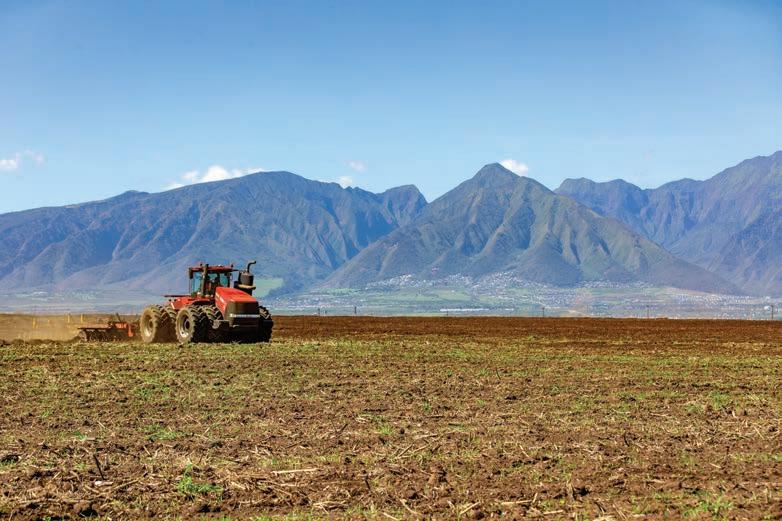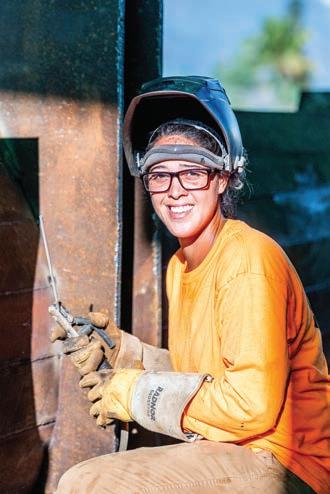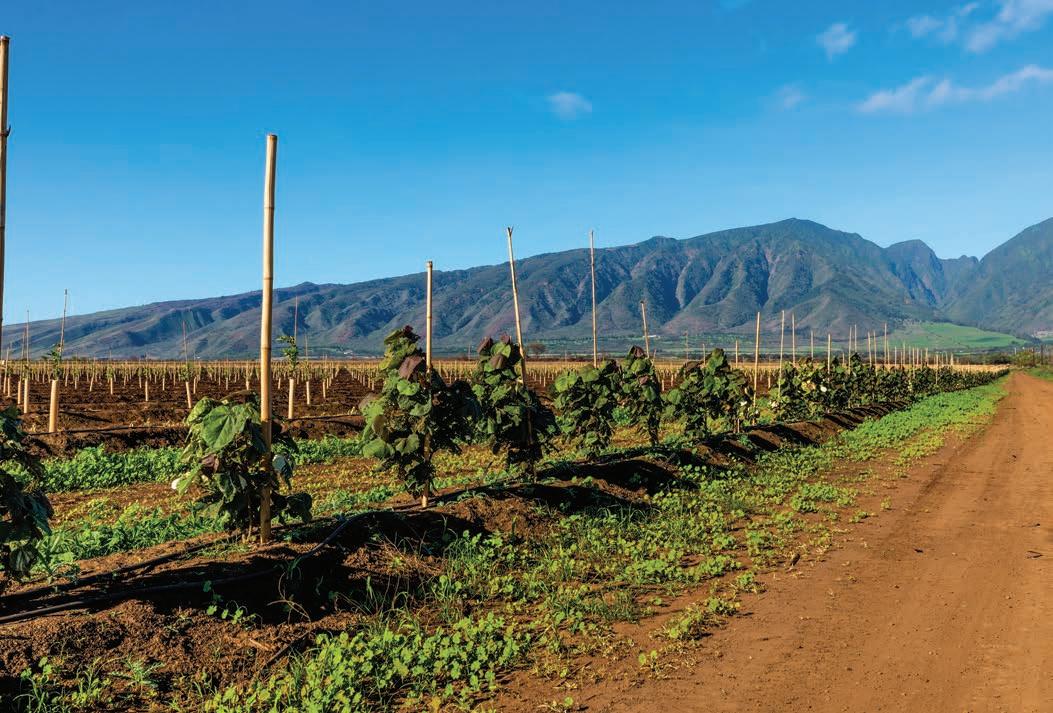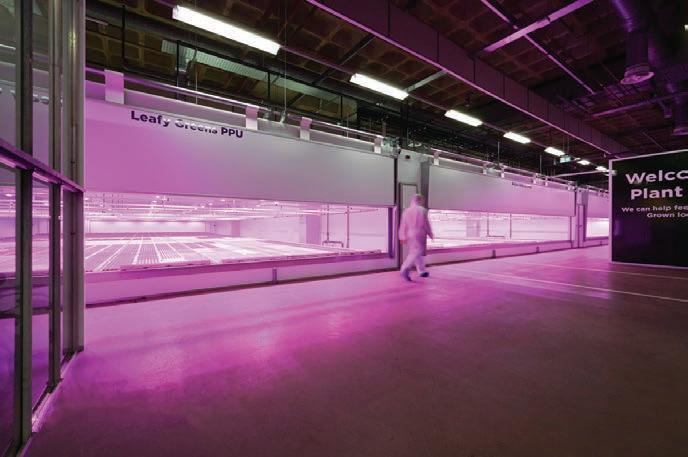
5 minute read
The Future of Food
The Future of Food of Food
A look at companies likely to defi ne and shape the future of the food industry
Advertisement

ALL IMAGES COURTESY MAHI PONO
Mahi Pono Diversifi es Crops on Maui Sugarcane Land
BY MEGHAN THIBAULT
Mahi Pono acquired 41,000 acres of former sugarcane land from Alexander & Baldwin over a year ago. Since then, the company has been preparing and planting the land in East Maui, replacing the long-term sugarcane monoculture with a diverse array of non-GMO crops.ahi Pono is a joint venture between Pomona Farming LLC, a California-based farming company, the Public Sector Pension Investment Board (PSP Investments), one of Canada’s largest pension investment management fi rms. Mahi Pono’s signature crop of potatoes has so far adapted well to Maui’s soil and climate. Red, white and yellow potatoes are successfully being grown and harvested in Puunene. The company kicked off 2020 with a donation of 30,000 pounds of potatoes to the Hawaiʻi Foodbank. According to reporting by Maui News, the company’s recent harvest passed a standardized Food and Drug Administration panel test. All studies came back clear, meaning that more than 400 chemicals, including
diquat and paraquat, were undetected in Mahi Pono’s potato crop. The company’s commercial harvest begins in earnest in mid-February, and Mahi Pono is estimating that their crop will yield 50,000 pounds of potatoes per week, a quantity that will signifi cantly reduce the need for imported potatoes from the mainland. The company has partnered with the Hawaii Foodservice Alliance to distribute crops as they come to harvest. “Residents will soon start seeing locally grown potatoes in retail stores and restaurants on Maui and eventually, across the state, wrote Mahi Pono Senior VP Shan Tsutsui, in a recent Maui Now op-ed. “Our long-term goal is to bring sustainable agriculture to Maui with strong, integrated farming practices that are economically viable, environmentally sound and good for our community. Mahi Pono is planting about 400,000 citrus trees, including lemon, lime, and orange trees. Other crops slated for planting include coff ee and breadfruit trees. More than 2,000 acres of pastureland have been earmarked for the com


pany’s expanding grass-fed beef production. Other crops being tested include varietal onions, along with papaya, mac nuts, avocado, and melons. According to Jayson Watts, Project Manager at Mahi Pono, they’ve been working closely with supermarket chains and other large and small retailers and entrepreneurs to determine which crops are most needed in Hawaii’s grocery stores. An initiative called “Chef’s Corner” hopes to supply needed ingredients for Hawaii’s vibrant dining scene. “We are open to working with

consumers. If restaurants and grocery stores want something specific, we are willing to work with them,” said Watts, who explained that the company holds local food security as one of its values. The company is still young enough and nimble

enough that they are able and willing to work with the community to fulfill existing needs.
With that in mind, Mahi Pono has made significant land investments, as well as capital expenditures on equipment and infrastructure. Investments in job creation have resulted in 130 full-time employees and 20 part-time jobs for Maui residents, all working to grow food on Maui, for Maui.
Mahi Pono is leasing 2-, 5-, and 10-acre parcels of land as a part of


its 200-acre community farm initiative designed to provide land to Maui residents looking to engage in farming on Maui. The cost is $150 per acre per year.
Applicants for the community farming initiative are required to submit a farm plan which is reviewed by a Community Farm Advisory Board. While these plans are evaluated, Mahi Pono is not dictating what successful applicants can grow. They’re looking to support stable, sustainable farm plans.
Armstrong Produce Partners with PlantLab
HFIA member Armstrong Produce has partnered with a Netherlands-based company called PlantLab. Using their cutting-edge technology, PlantLab has developed an indoor, controlled growing environment that maximizes resources like water and light to grow and harvest crops year-round in an indoor lab. PlantLab’s plant production unit (or PPU) is known as a Plant Paradise®.
The partnership is developing a 60,000 square-foot, multi-layered PPU near the airport. Armstrong Produce will serve as PlantLab’s distribution partner, capitalizing on their already established infrastructure and relationships with buyers. “When we talk about the products that are going to be grown, we want to target the kinds of crops that are 100% imported. Sustainability means that you have to diminish what you’re importing,” said Armstrong’s Director of Marketing Tisha Uyehara. The partnership will by growing different varieties of lettuce. While grown here, Uyehara noted lettuce isn’t grown with enough volume to produce economies of scale to supply supermarkets and restaurants. “It’ll produce fresher produce, grown in Hawaii. It’s cost-effective from an energy use point of view, and solar power may help to offset some of the costs of electricity.” Depending on the commodity being grown, the growing cycle is generally between two and three weeks, Uyehara told us.
Plants respond well to red and blue LED lights so that the PPUs can be operational even in the dark of night. PlantLab’s Plant Paradise® can operate 24/7, resulting in a year-round growing, no matter where their plant production units are located. The prototype of PlantLab‘s first plant production unit was completed in 2006. The goal was to develop an ideal, closed growing environment using their knowledge of plant physiology and technology to optimize all growing conditions. PlantLab doesn’t modify the plants themselves. Instead, they’ve created an ideal growing environment by controlling variables like humidity, airflow, light, root temperature and irrigation. They do so using stateof-the-art technology, a multi-layered growing system, mathematical modeling, and top-notch insights into plant physiology.
PlantLab’s “precision agriculture” uses resources in a highly targeted way, so that foods can be grown closer to consumers using less than 10 percent of traditional water usage. PlantLabs need less than half the quantity of fertilizers used in conventional farming and operate without the use of herbicides or pesticides.
The result is a reduction in marketing and transportation waste. Given Hawaii’s distance from the mainland, where much of our food is grown, transportation not only adds to our food costs but also impacts our environment.
“The fact that it’s going to be produced here, it’s a local product, and can be at the customer the day after it’s harvested is a huge benefit,” said Uyehara. “For us, it’s all about having consistent supplier products because our customers depend on it. It has to be of good quality and done consistently.”









